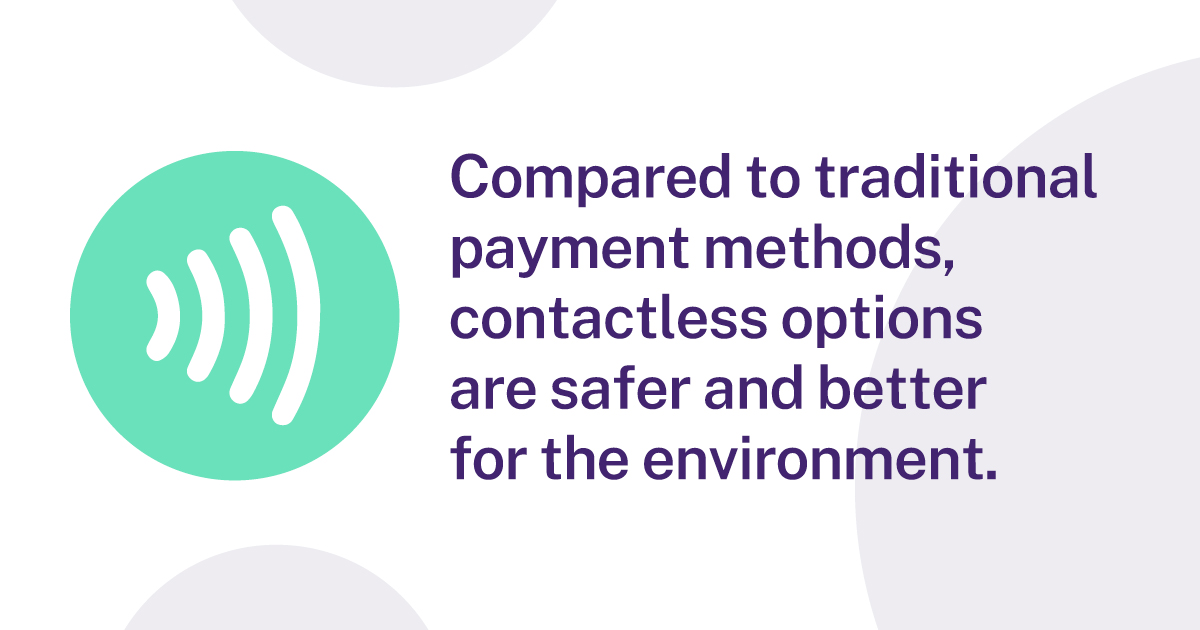Contactless payments offer consumers a faster, more convenient way to pay for goods and services. Although this technology has existed for decades, the 2020 pandemic accelerated adoption; consumers were suddenly more aware of the health and environmental impacts of physical payment methods and demanded an alternative. McKinsey dubbed this spike in digital growth and innovation “the Quickening.”
While much of the world has returned to “business as usual,” new payment options like tap to mobile, mobile wallets and QR codes are here to stay.
Consumers expect businesses to provide contactless and digital payment services. They’re no longer just a convenience – they’re a necessity. With the contactless payments industry on pace to exceed 10 trillion dollars by 2027, merchants are racing to keep up with consumer demand.
Contactless payments are popular for their speed, efficiency, security and improved customer experience. However, they offer other real-world advantages as well. In honor of World Health Day and Earth Day this month, we’ve taken a closer look at how contactless payments can improve global health and the environment.
Types of contactless payments
Contactless payments authorize transactions without physical contact between a card or payment device and the point of sale (POS) terminal. There are several contactless payment technologies available, including:
- Tap-to-mobile
- Mobile wallets
- QR code scanners
- App transfers
Even more impressive than the number of options available to consumers is how quickly innovative fintechs have advanced and grown the space in recent years. For instance, cutting-edge systems like biometric payment verification use palm and iris scans to allow consumers to make secure payments without carrying a single card or payment device.
Minimizing the points of contact and number of steps required to perform a transaction streamlines the shopping experience and plays a positive role in the environment and global health.

How Contactless Payments Impact Health and Safety
Contactless payments impact health and safety in multiple ways. The most obvious is by minimizing the number of times consumers touch potentially contaminated surfaces.
Studies have shown that money is a perfect vector for all things unsanitary, including E. coli, salmonella and viruses like influenza, norovirus and more. While it’s no surprise that money can be filthy, few people realize that nearly 79% of one-dollar bills test positive for trace amounts of cocaine. While traces of the drug are too small to be harmful, the statistic demonstrates how “sticky” money can be and how often bills and coins are passed around.
Although credit and debit cards may appear to be a healthier alternative, some studies have found that plastic cards are even dirtier than paper and metal monies. A 2019 study found that the average payment card has nearly twice as many germs as cash or coins. The same study also found that urinals at Penn Station were significantly cleaner than the average payment card, with roughly the same “germ score” as paper money.
Unfortunately, payment methods that require consumers to enter a PIN number only add to the problem. In 2020, another study took 130 samples from 24 grocery stores in Toronto and found that PIN pads had the most germs of any tested surface. PIN pads were dirtier than basket handles, baby seats and shopping cart handles.
Compared to paper, metal and even plastic payment options, contactless payments are by far the most hygienic option available. After all, fewer touchpoints result in reduced exposure to germs and transmissible illnesses.
How Contactless Payments Impact the Environment
On the environmental side, contactless technologies help to reduce the carbon footprint associated with the payments industry. The amount of physical cash in use today is mind-boggling – there are almost 40 billion banknotes in circulation in the United States alone, and another 28 billion coins.
The government requires considerable resources to put physical currencies into circulation. For instance, consider small-denomination coins like pennies and nickels. These coins famously cost more to make than they’re worth.
Contactless, digital payments help us reduce our dependence on cash and coins, which reduces our reliance on the mining, deforestation and processing required to make them.
Plastic payment cards certainly aren’t perfect. However, many businesses are giving cards a “green” makeover to reduce the impact they have on the environment. Today, green payment cards made with recycled plastics are becoming the norm; some banks even offer biodegradable cards that, in the right environment, reduce breakdown time from hundreds of years to a matter of weeks.
Better still, payment cards may be on their way out as growth in mobile payment solutions, digital wallets and biometrics eliminate the need to carry them. By utilizing the things we already have with us, like cell phones, contactless payments reduce the raw inputs needed to make payments work (and the amount of waste left over at the end of the process).
Other Benefits of Going Contactless
Aside from the health and environmental benefits, contactless payments offer several other advantages, such as improved security, convenience and buying experience.
For instance, contactless payments are more secure than traditional payment methods. Since payment data is encrypted and stored digitally with contactless technology, there is a lower risk of fraud or theft. Add a biometric layer, like the face scans used by Apple Pay and other digital wallets, and security goes through the roof.
Contactless payments are also more convenient and efficient. Consumers can complete transactions quickly and easily without needing physical cash or cards. This improves the overall customer experience and encourages consumers to make more frequent purchases – a significant upside for merchants.
More Than Just a Convenience
Contactless payments are more than just a convenience; they reduce the spread of germs and viruses. Over time, this leads to better health outcomes and minimizes the environmental impact of payment processing. Contactless technologies like mobile and biometric payments push us further from traditional cash and cards, making the payments industry greener and more health-conscious.
To learn more about the benefits of contactless and digital payments, contact a member of our team and schedule a consultation.
Don’t just turn on payments, transform the way you do business
- Generate New Revenue By adding or expanding payment offerings to your solution, you can start earning higher monthly and transaction-based recurring revenue.
- Offer the Power of Choice Allow merchants to choose from 125+ shopping cart integrations and 200+ processor options to streamline their onboarding.
- Seamless White Labeling Make the platform an extension of your brand by adding your logo, colors and customizing your URL.





